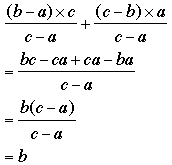| |||
| Math Central | Quandaries & Queries |
|
Question from Kenneth: Hello: I am interested in determining the answers to the following question by using some type of weighted average: An investor has $30,000 to invest at simple interest in two accounts. One account earns 2% and the second earns 5%. How much must he invest in each account if his total return is 4% or $1,200? Here is a possible solution: I want to determine the answers without using the above equation. I discovered how to determine these fractions of 1/3 and 2/3 without first solving the equation: 2%----3%----4%----5% From 2% to 5%, 2% is 2/3 of the distance to 4%. From 5% to 2%, 5% is 1/3 of the distance to 4%. I thank you for your reply. |
Kenneth,
In your example you know the weights are 1/3 and 2/3. Since 4% is closer to 5% than it is to 2% , 5% must get more weight than 2% and hence he must invest two-thirds of the $30,000 at 5% and the remaining one-third at 2%.
To see the general result suppose the percentages were a%, b% and c% with a < b < c. You found the weights as
(b - a)/(c - a) and (c - b)/(c - a).
The correct calculation is
since this is
Penny
Kenneth wrote back
I want to thank you for your reply. My mathematical level of thinking is not as advanced as I would like.
Can you explain in general terms why 5% must get more weight, 2/3?
5% is closer to 4%. It would seem reasonable that 2% should get more weight since it is farther from 4% to bring it closer to 4%.I thank you for any helpful explanation that you can offer.
Kenneth,
The factors 2% and 5% are the interest rates of the two accounts. These values are fixed, you can't change them. The 4%, which you might call the effective interest rate, is determined by how much you have in the 5% account and how much you have in the 2% account. If all your money is in the 5% account then the effective rate is 5% and if all your money is in the 2% account then the effective rate is 2%. If you have half your money in each account then the effective rate will be half way between 2% and 5%, that is (2% + 5%)/2 = 3.5%. Since your effective rate is 4%, closer to 5% than to 2%, you must have had more money in the 5% account than in the 2% account. You already determined that the weights are 2/3 and 1/3 so you must have two-thirds of your money in the 5% account and one-third in the 2% account.
I hope this helps,
Penny
 |
||
Math Central is supported by the University of Regina and The Pacific Institute for the Mathematical Sciences.
